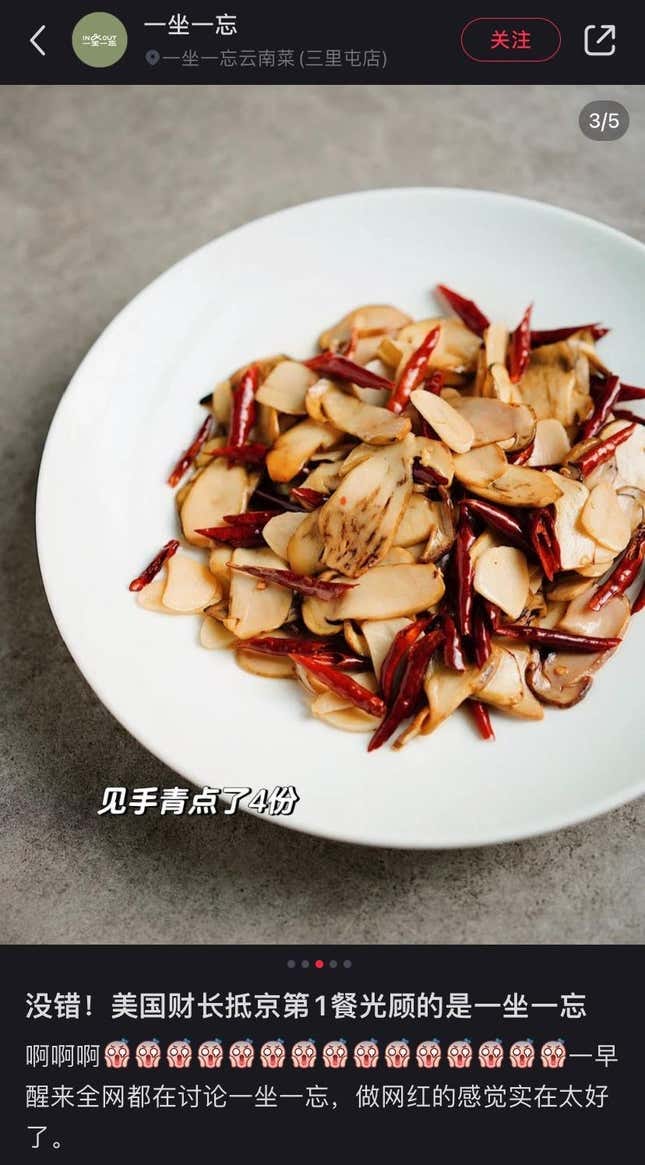Treasury Secretary + Shrooms = "Mushroom Diplomacy"?
Treasury Secretary Janet Yellen reportedly ate magic mushrooms for dinner in China; CNN touts it as "mushroom diplomacy"...but what really happened?
Reports have surfaced that Treasury Secretary Janet Yellen dined on a dish containing a Chinese variety of magic mushroom during her recent visit to China. The mushroom, known in Chinese as jian shou qing (which translates to “see hands blue”) is thought to contain psychoactive alkaloids which break down when the mushrooms are cooked, rendering them non-psychoactive in their culinary form. CNN spun the story as “mushroom diplomacy,” presumably tongue-in-cheek. But the mushroom has managed to pique the interest of both the Chinese Center for Disease Control and an office within the US Department of Energy. While it is all a bit silly on the surface, the story sheds light on the role of mushrooms both as trendy commodities and as symbols for social—potentially even political—meaning.
United States Treasury Secretary Janet Yellen recently returned from a trip to China, where she visited with Chinese Premier Li Qiang, Vice Premier He Lifeng, and others to discuss US-Chinese trade relations. Tech sanctions, the Ukraine war, and climate change were all on the agenda as Yellen attempted to mend the somewhat frayed relationship between the two countries.
The visit seemed to go relatively well, with CNN and others reporting that Yellen received a “warmer reception” than Secretary of State Antony Blinken did during his visit last month.
Hong Kong-based journalist Maggie Hiufu Wong wrote that Yellen’s trip to China “resulted in one unexpected success”: it “dramatically boost[ed] business for a Yunnan restaurant” that serves a “highly sought-after mushroom prized for its unique properties.” This particular variety of mushrooms is known as jian shou qing in Mandarin, which translates to “see hands blue.” It is so-named due to the blue color which appears when the mushrooms are handled (something which psilocybin enthusiasts recognize as a sign of psychoactive potency). Jian shou qing is native to the Yunnan province of China, where it is frequently enjoyed as cuisine by locals.1
The sales boost occurred in direct response to reports that Secretary Yellen ordered the mushroom dish from the restaurant, named Yi Zuo Yi Wang (or “In and Out”). After the story gained traction on the Chinese social media site Weibo, the restaurant confirmed that it had indeed served the dish to Secretary Yellen, who ordered four portions of it. According to the staff there, Secretary Yellen thoroughly enjoyed the mushrooms. The restaurant also explained that they always serve the mushrooms “fully cooked” to avoid any unwanted effects. Yellen was on a diplomatic trip, not a psychedelic trip, after all.
According to Wong, jian shou qing is “an umbrella term for a family of mushrooms” but is most closely associated with the species Lanmaoa asiatica. Not much is currently known about jian shou wing. We don’t even know whether psilocybin is the alkaloid responsible for the psychoactive effects. Most of what we do know about it comes from Yunnan locals, who seem to have been aware of the mushroom’s mind-altering qualities for generations.
There are, however, scattered references to the mushroom throughout the web. One which I find particularly interesting is a page on MycoCosm, a genomic encyclopedia of fungi created by an office within the US Department of Energy. On it, a couple lines caught my eye:
“We aim to clarify the genetic basis for the secondary metabolites responsible for its aroma and hallucinogenic properties, which…could provide some insight into the proper utilization and medical treatment for this fungus and its allies.”
I also found a document from the Chinese Center for Disease Control that mentions the mushroom.
The document states that Lanmaoa asiatica “could cause hallucinations” but explains that “its toxicity it still unclear and needs further studies.” It also indicates that there were at least two documented cases of non-lethal poisoning involving the species in Yunnan in 2021.
Keep reading with a 7-day free trial
Subscribe to The Politics of Psilocybin to keep reading this post and get 7 days of free access to the full post archives.











